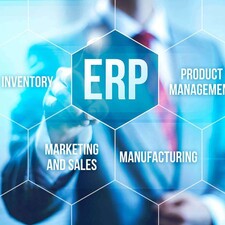Blog
Integrating your supply chain with extended supply chain portals

Summary
Most people think of ERP systems in terms of deploying a central interface within a company through which every functional area of a business can efficiently communicate and access data. But today, ERP systems should not be restricted to internal operations - they must take you outside the walls of your business and extend the supply chain through web portals.
What are extended supply chain portals?
The extended supply chain refers to the ability to manage relationships with vendors and customers through an interface to your ERP system. Extended supply chain portals in an ERP system are all about creating one common interface for you to communicate with external vendors and customers.
Rather than managing relationships with external parties through emails, phone calls, faxes and in-person meetings, the portals allow vendors and customers to enter information into the system without having to contact an account manager. The information - which could include purchase orders, invoices, pricing changes, customer feedback or any other data coming from external parties - is automatically taken from the portal and entered into the ERP system so employees and managers can take action right away.
The benefits here include more efficient operations, and fewer chances to make data entry errors that arise when your employees have to manually enter information into separate systems. Furthermore, your account managers can focus more on high-value tasks. abas' MRP (Material Resource Planning) will generate procurement suggestions based on a demand, allowing vendors to manage your inventory for you. The account manager will be able to review and approve changes, readjust the MRP settings, negotiate prices, and create new partnerships with suppliers.

The EDI Center in abas ERP is a supervision tool where all EDI transactions come and go.
Bringing the benefits of EDI to all relationships
Electronic data interchange (EDI) has become the standard method for communication between companies throughout a supply chain, and is a common feature in most ERP systems. EDI allows you to send things like purchase orders to vendors or invoices, and shipping information to customers electronically. For example, if a customer sends an EDI message regarding an order, it will identify all of the relevant information: location, price, quantity, lot data, etc. On the receiving end, your ERP software can take that message and automatically translate the order into its own internal system. Essentially, it's a common language between applications/modules.

The purchase order feature in abas USA's vendor portal..
EDI is near ubiquitous for enterprise-level and midmarket companies that handle thousands of transactions each day. However, investing in these capabilities generally won't provide a steady return on investment for small vendors that may only participate in a few transactions on a daily basis. Therefore, smaller companies may lack the capability to use EDI for communication.
Regardless of what kind of business partner you work with, efficient communication that optimizes the relationship is essential. abas ERP makes it easy to manage these relationships by offering a Web portal as a common interface that any vendor can access and use for communication.

The purchase suggestion release feature in abas USA’s vendor portal.
Integration with the workflow editor
In a previous post, we discussed the value of the workflow editor, which allows abas power users to create specific, controlled workflows for their users to follow based on the information entered into the system. The extended supply chain portals integrate with the workflows to automate key processes.
For example, inventory management processes depend on accurate and timely communications with vendors. abas ERP can make purchase order suggestions that let the vendor know if your stock for a particular part runs low, and will instantly inform the vendor to replenish inventory. The vendor can also use the portal to alert you when they've sent a shipment, this way when you receive the parts, you already have the information you need to account for them internally.
On the customer side, there is a sales or service module through which customers can communicate. Whether they have a service request, or simply want to place another order, they have access to prior data. They can see quotes, orders, and shipments in real-time. This is powerful, especially if you don't have a dedicated e-commerce platform, because you can still use the ERP system's portal to communicate with your customers.

In the customer portal, you can view blanket order (contracts), quotes, sales orders, shipments, and invoices.
Essentially, extended supply chain order portals can be seen as a way to extend the functionality of your ERP system beyond your own internal operations, and integrate all of your vendor and customer relationships into one convenient and user friendly interface.

The service section of the customer portal is where you can manage the products you bought and create RMA's, get updates, and communicate with the service department.


